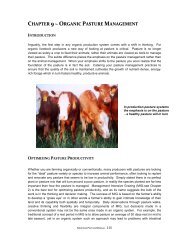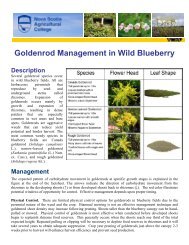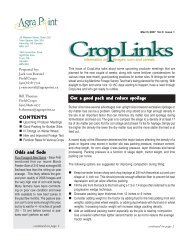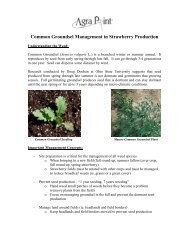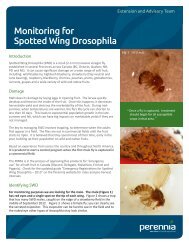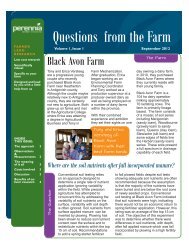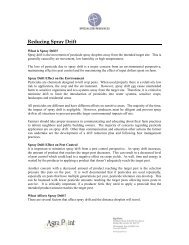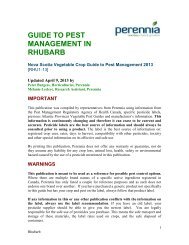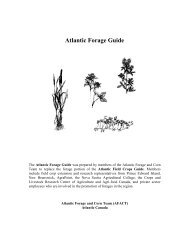Wireworms - Perennia
Wireworms - Perennia
Wireworms - Perennia
You also want an ePaper? Increase the reach of your titles
YUMPU automatically turns print PDFs into web optimized ePapers that Google loves.
<strong>Wireworms</strong><br />
<strong>Wireworms</strong> are the larvae of click beetles (Family Elateridae). Three species of wireworms are<br />
found in Nova Scotia: Agriotes lineatus, A. obscurus and A. sputator.<br />
Identification:<br />
Wireworm larvae are orange to brown in colour, shiny, slender and hard bodied. There are six<br />
legs toward the head region and at the head; there is a pair of pincer-like protrusions.<br />
<strong>Wireworms</strong> usually reach a size of 1-4 cm (0.4-1.6 inches) in length.<br />
Magnification = 2.5 x<br />
Adult Click Beetle<br />
(Photo by: Stephen Crozier, NSAC)<br />
Magnification = 3 x<br />
Click Beetle Larva (Wireworm)<br />
(Photo by: R.E.L. Rogers, Wildwood Labs Inc.)<br />
Damage:<br />
<strong>Wireworms</strong> will feed on seeds, young plants, roots and tubers of carrots, potatoes, corn, turnip,<br />
sweet potato and other root crops. The insect will tunnel into roots and tubers, causing holes that<br />
reduce the quality of the crop. Wireworm damage is more severe in crops planted on land that<br />
has recently been converted from sod or in fields that have many grassy and broadleaf weeds.<br />
Monitoring:<br />
If growers are planting into an unknown field or growing a crop in a field that is coming out of<br />
sod, it is advised to monitor the field for wireworm populations.<br />
A simple technique is to dig several holes on the diagonal of the field and place a carrot or<br />
freshly cut potato 10 cm deep. Place cheese cloth over top of the carrot or potato. Cover the<br />
hole with soil, mark the spot and 2-3 days later examine. If one or two wireworms are found per<br />
sample, then it can be concluded that wireworms are well established in the field treatment is
necessary. If wireworm populations have reached high levels, it will take several years to<br />
eliminate or bring populations below threshold levels.<br />
Lifecycle:<br />
September:<br />
Larvae and pupae<br />
begin<br />
overwintering.<br />
April - June:<br />
Overwintering<br />
larvae become<br />
active; some feed<br />
and pupate.<br />
Adult click<br />
beetles emerge<br />
and mate<br />
July: Eggs hatch,<br />
new larvae begin<br />
feeding, older<br />
larvae feed and<br />
some pupate.<br />
August: Larvae<br />
continue feeding<br />
and some pupate.<br />
Best Management Techniques:<br />
<strong>Wireworms</strong> in the soil are feeding off of decomposing organic plant material; therefore forage in<br />
the vegetable or potato rotation is undesirable. Crop rotation is extremely important in managing<br />
wireworms and as part of a control strategy, growers are advised not to grow crop in which<br />
wireworms thrive, mainly hay and sod, but instead to grow crops which can be treated for<br />
wireworms, such as wheat and corn. Trap cropping using a wheat crop treated for wireworms is<br />
exceptionally important as part of the overall control strategy, but even more so in fields with<br />
high infestation levels. Shallow cultivation in summer fallow situations helps to expose the<br />
wireworm larvae to birds and predators or mechanical damage.<br />
Insecticide application is an important part of overall wireworm management. For the 2007<br />
growing season, Furadan 480 F systemic liquid insecticide has been registered in Nova Scotia for<br />
the reduction in numbers of wireworms. Please refer to the supplemental label for more<br />
information.<br />
Managing wireworms requires regular and consistent monitoring and diligent field management;<br />
there is no quick fix solution for this pest.<br />
For more information, please refer to the more detailed wireworm article at www.agrapoint.ca or<br />
contact: Alana Respondek, Horticulture Crop Specialist or Dr. Viliam Zvalo, Horticulture Crop<br />
Specialist at (902) 678-7722 or AgraPoint’s Ag Info Centre 1-866-606-4636.<br />
© AgraPoint International Inc.<br />
Page 2 of 2



